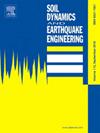An improved time-domain spectral matching algorithm for peak adjustment and convergence efficiency optimization
IF 4.2
2区 工程技术
Q1 ENGINEERING, GEOLOGICAL
引用次数: 0
Abstract
Nonlinear time history analysis is necessary for the seismic design of complicated or irregular structures. Compared to artificial ground motion, real earthquakes matched with the target spectrum are more favorable, since the matched ground motions (generated by spectral matching algorithms) can better preserve the period and phase characteristics. Therefore, an improved time-domain spectral matching algorithm is proposed to generate ground motion time history that matches the target response spectrum. The proposed algorithm introduces a new period subdivision sorting strategy and an adaptive convergence parameter selection method to improve the convergence efficiency of spectral matching. In addition, a peak ground acceleration (PGA) correction algorithm is introduced to maintain PGA consistency. The effectiveness of the proposed method is validated by several real earthquake records, and the method is compared with an existing time spectral matching algorithm. Based on the matched results, the period subdivision sorting strategy can effectively reduce mutual interference from added adjustment wavelets, and the adaptive convergence parameter selection method considers the correlation between wavelet functions and provides better numerical stability to improve convergence efficiency. The proposed PGA correction algorithm provides high PGA matching accuracy and omits velocity and displacement drifts.
一种改进的时域谱匹配调峰算法及收敛效率优化
非线性时程分析对于复杂或不规则结构的抗震设计是必要的。与人工地震动相比,与目标频谱匹配的真实地震更有利,因为匹配后的地震动(由频谱匹配算法生成)能更好地保留周期和相位特征。为此,提出了一种改进的时域谱匹配算法,生成与目标响应谱匹配的地震动时程。该算法引入了一种新的周期细分排序策略和自适应收敛参数选择方法,提高了光谱匹配的收敛效率。此外,还引入了峰值地加速度校正算法,以保持峰值地加速度的一致性。通过实际地震记录验证了该方法的有效性,并与已有的时间谱匹配算法进行了比较。在匹配结果的基础上,周期细分排序策略可以有效降低附加调整小波的相互干扰,自适应收敛参数选择方法考虑了小波函数之间的相关性,提供了较好的数值稳定性,提高了收敛效率。提出的PGA校正算法具有较高的PGA匹配精度,并且忽略了速度和位移漂移。
本文章由计算机程序翻译,如有差异,请以英文原文为准。
求助全文
约1分钟内获得全文
求助全文
来源期刊

Soil Dynamics and Earthquake Engineering
工程技术-地球科学综合
CiteScore
7.50
自引率
15.00%
发文量
446
审稿时长
8 months
期刊介绍:
The journal aims to encourage and enhance the role of mechanics and other disciplines as they relate to earthquake engineering by providing opportunities for the publication of the work of applied mathematicians, engineers and other applied scientists involved in solving problems closely related to the field of earthquake engineering and geotechnical earthquake engineering.
Emphasis is placed on new concepts and techniques, but case histories will also be published if they enhance the presentation and understanding of new technical concepts.
 求助内容:
求助内容: 应助结果提醒方式:
应助结果提醒方式:


